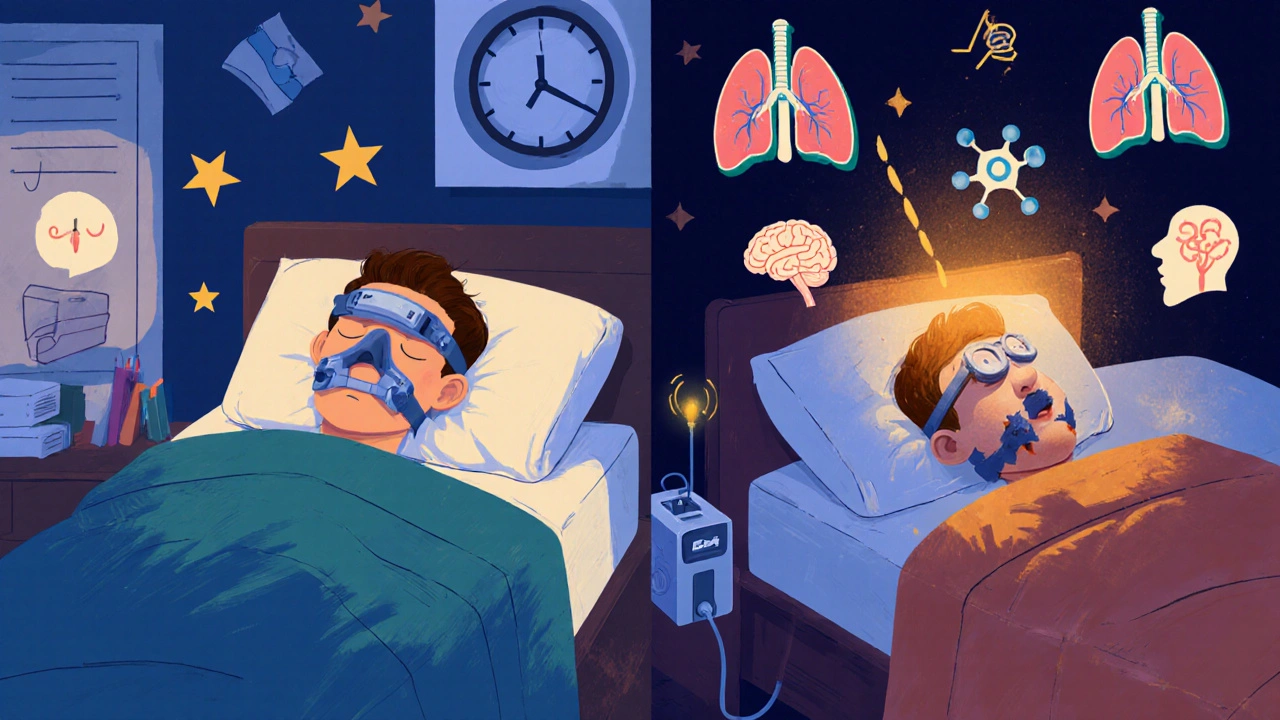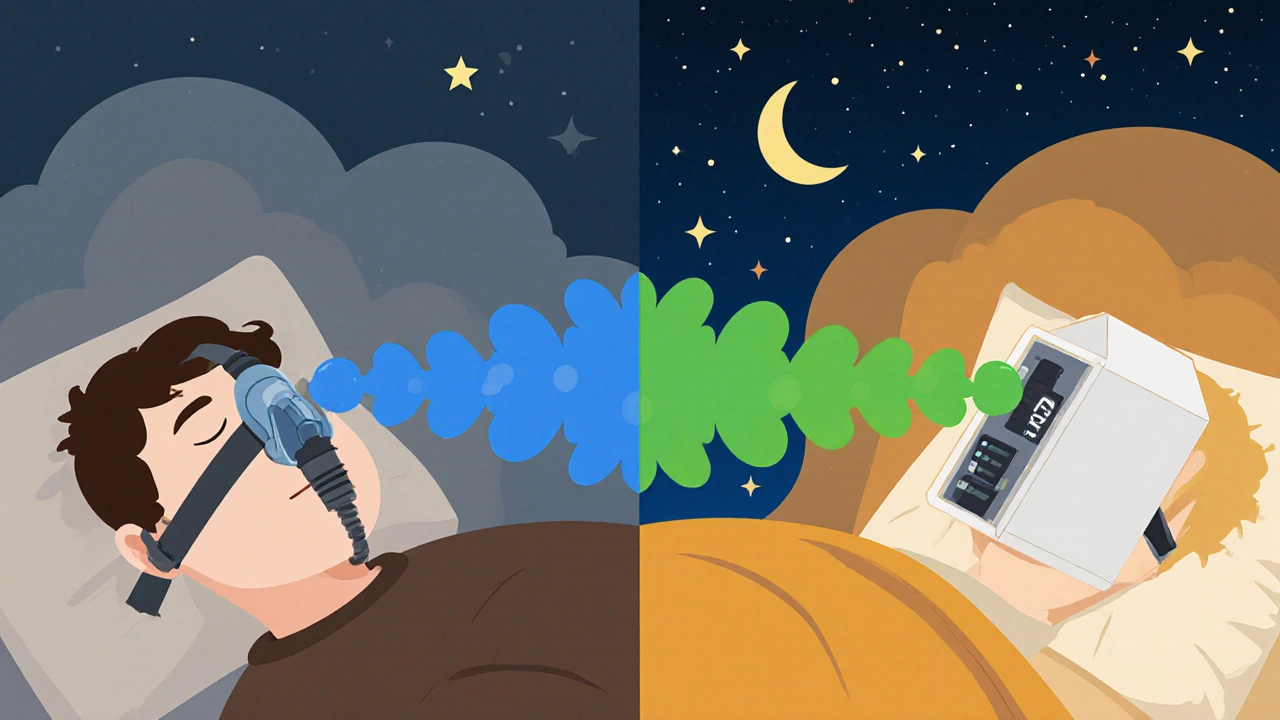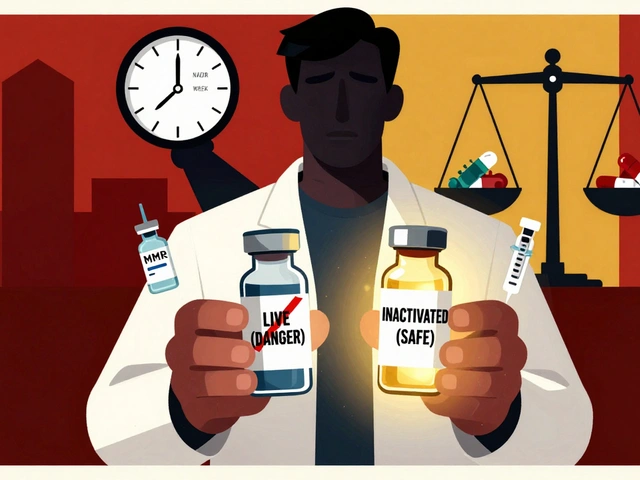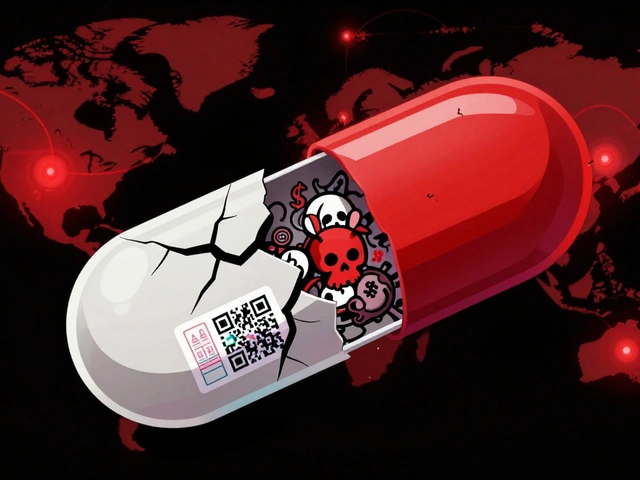Choosing between a CPAP and a BiPAP machine isn’t about which one is better-it’s about which one works for your breathing needs. Both devices help you sleep better by keeping your airway open, but they do it in very different ways. If you’ve been told you need one of these machines after a sleep study, it’s easy to feel overwhelmed. You might wonder why your doctor picked one over the other, or if you could switch later. The truth is, most people start with CPAP. But for some, BiPAP isn’t just an alternative-it’s the only thing that makes breathing feel natural again.
How CPAP Works (And Why It’s the Go-To for Most People)
CPAP stands for Continuous Positive Airway Pressure. It’s been the standard treatment for obstructive sleep apnea since the early 1980s. The machine delivers a steady stream of air through a mask, keeping your throat from collapsing while you sleep. Think of it like a gentle, constant breeze holding your airway open-no matter if you’re inhaling or exhaling.
Most CPAP machines operate between 4 and 20 cm H₂O of pressure. That’s not a lot-about the same as blowing through a straw halfway submerged in water. But for someone with sleep apnea, it’s enough to prevent dozens, sometimes hundreds, of breathing pauses each night. The device doesn’t adjust pressure based on your breath. It just keeps pushing air at the same level all night long.
Why is this the first choice for 85-90% of people diagnosed with obstructive sleep apnea? Because it’s simple, proven, and effective. A 2023 review of over 1,800 patients showed CPAP reduces apnea events by 90% or more when used correctly. It’s also the most affordable option, with basic models starting around $500 and most insurance plans covering most of the cost after a sleep study.
But here’s the catch: exhaling against constant pressure can feel like breathing through a heavy blanket. For people who need high pressures-say, 15 cm H₂O or more-that resistance becomes tiring. That’s where BiPAP steps in.
How BiPAP Works (And Why It Feels Different)
BiPAP, or Bilevel Positive Airway Pressure, gives you two different pressure levels: one for breathing in (IPAP), and a lower one for breathing out (EPAP). So instead of fighting against the same pressure all night, you get a boost when you inhale and a break when you exhale. It’s like having a helper gently push air into your lungs, then letting you breathe out more easily.
Typical BiPAP settings might be IPAP 14 cm H₂O and EPAP 8 cm H₂O. That means you’re getting 6 cm H₂O of pressure relief on every exhale. For people struggling with high CPAP pressures, that difference can be game-changing. One user on Reddit described it this way: “BiPAP at 14/8 felt like breathing normally. CPAP at 14 felt like choking.”
But BiPAP isn’t just about comfort. It’s also built for more complex conditions. Unlike CPAP, many BiPAP machines have a “backup rate” feature. If you stop breathing for too long-say, because of central sleep apnea-the machine will force a breath. This is critical for people with heart failure, neurological disorders, or brain-related breathing problems where the body doesn’t send the right signal to breathe.
BiPAP also helps people with COPD who still have sleep apnea (called overlap syndrome). These patients often have high carbon dioxide levels at night. The extra push on inhale helps clear out stale air, while the lower exhale pressure keeps them from working too hard. A 2022 study found BiPAP reduced respiratory effort by 30-40% compared to CPAP in this group.
When You Need BiPAP (Not Just CPAP)
BiPAP isn’t for everyone. In fact, for simple obstructive sleep apnea without other health issues, it’s usually not needed. But there are clear medical reasons to choose it:
- High CPAP pressure needs (15 cm H₂O or higher) - Exhaling against that much pressure becomes exhausting. BiPAP reduces that strain.
- Chronic Obstructive Pulmonary Disease (COPD) with sleep apnea - BiPAP helps clear CO₂ buildup and improves oxygen levels.
- Central sleep apnea - Your brain isn’t telling your lungs to breathe. BiPAP’s backup rate can trigger breaths when needed.
- Obesity hypoventilation syndrome - People with BMI over 30 and high CO₂ levels often need the extra support BiPAP provides.
- Neuromuscular diseases - Conditions like ALS or muscular dystrophy weaken breathing muscles. BiPAP can compensate.
According to the American Thoracic Society, BiPAP is the recommended first-line therapy for all these conditions-not as a backup, but as the standard. If you have any of these diagnoses, your doctor should consider BiPAP from the start.
But here’s the reality: many people are prescribed BiPAP unnecessarily. A 2023 analysis found that $420 million is wasted annually in the U.S. because BiPAP machines are ordered for simple sleep apnea cases where CPAP would work just fine. Insurance companies know this. Medicare won’t approve BiPAP unless you’ve tried and failed CPAP first-specifically, if you can’t tolerate 15 cm H₂O for 4 hours a night over 30 days.

Cost, Coverage, and What You’ll Pay
CPAP machines are cheaper to buy and easier to get covered. Basic models range from $500 to $1,200. The ResMed AirSense 10, one of the most popular, retails for $899. Most private insurers and Medicare cover 80% of the cost after a sleep study.
BiPAP machines? They start at $800 and can go up to $1,800. The Philips DreamStation BiPAP Auto sells for $1,499. Insurance coverage is stricter. Medicare requires proof that CPAP didn’t work before they’ll pay for BiPAP. Even then, you’ll likely need a letter from your sleep doctor explaining why the higher pressure is medically necessary.
Don’t assume BiPAP is “better” just because it’s more expensive. It’s not. It’s more complex-and sometimes essential. But if you have simple obstructive sleep apnea and tolerate CPAP well, there’s no reason to switch.
Real User Experiences: What People Actually Say
Surveys of over 12,000 users show CPAP users report higher satisfaction with ease of use. 71% rated it “excellent” for simplicity. BiPAP users? Only 58% said the same. Why? Because BiPAP has more settings, more modes, and more things that can go wrong.
One common complaint: “The machine keeps switching pressure at the wrong time.” That’s called “cycling issues.” About 27% of BiPAP users report this in surveys. It happens when the machine misreads your breathing pattern and delivers pressure at the wrong moment. That can feel like gasping or choking.
On the flip side, users who truly need BiPAP often say it changed their lives. A 2023 survey found BiPAP users with complex conditions used their device 68% of nights for at least 6 hours-higher than CPAP users with simple apnea. Why? Because they could actually breathe. They weren’t fighting the machine. They were sleeping.
One man in his 60s with COPD and severe sleep apnea told his sleep tech: “I used to wake up every hour, gasping. I thought that was just getting older. BiPAP let me sleep through the night for the first time in 10 years.” That’s the real win.

Setting Up and Sticking With It
Both machines require a sleep study to determine the right pressure. CPAP titration usually takes one night. BiPAP takes longer-often 1.5 to 2 nights-because you need to find the right balance between IPAP and EPAP.
Getting used to either device takes time. Most people need 2-4 weeks to adjust to CPAP. BiPAP can take 3-6 weeks because there’s more to learn. Humidity settings, mask fit, ramp features-all matter. And if you’re on a BiPAP with backup mode, you’ll need to understand what “S/T mode” means (spontaneous/timed). That’s not something you can figure out from a YouTube video.
That’s why professional support matters. ResMed says 92% of CPAP users successfully use self-help guides. Only 78% of BiPAP users can. For BiPAP, working with a respiratory therapist is often necessary, especially if you have a chronic condition.
And don’t underestimate the mask. A bad fit causes 70% of early discomfort. It doesn’t matter if you’re on CPAP or BiPAP-if the mask leaks, you’re not getting the therapy. Try different styles: nasal pillows, full face, hybrid. Don’t settle for the first one they give you.
What’s Next? The Future of Sleep Therapy
Manufacturers are making both machines smarter. ResMed’s AirCurve 10 VAuto uses AI to adjust pressure in real time based on your breathing. Philips’ DreamStation 3 now includes built-in oxygen sensors. These aren’t just gimmicks-they’re responses to real problems: people quitting because the machine doesn’t adapt to them.
But the biggest shift isn’t in the tech-it’s in the thinking. More doctors are realizing that not all sleep apnea is the same. One-size-fits-all doesn’t work. BiPAP isn’t a “upgrade” to CPAP. It’s a different tool for a different job.
As obesity and aging populations rise, complex cases are growing. BiPAP use is expected to increase 15-20% annually through 2027. But that doesn’t mean you should ask for it unless you need it.
If you’ve been told you need a PAP machine, ask: “Is this for obstructive sleep apnea alone? Or do I have another condition?” If it’s just apnea, CPAP is still the best starting point. If you have COPD, heart failure, or central apnea-BiPAP might be your only path to restful sleep.
Don’t let price or fear of complexity stop you. But don’t let marketing or assumptions push you into a machine you don’t need. The right device isn’t the fanciest one. It’s the one that lets you breathe-and sleep-without thinking about it.
Can I switch from CPAP to BiPAP later?
Yes, you can switch from CPAP to BiPAP if your doctor determines you need it. Common reasons include needing higher pressure (above 15 cm H₂O), developing central sleep apnea, or having COPD or another chronic lung condition. Your sleep specialist will need to order a new sleep study to set the right IPAP and EPAP levels. Insurance may require proof that CPAP didn’t work before approving BiPAP.
Is BiPAP more effective than CPAP for sleep apnea?
For simple obstructive sleep apnea, no. Multiple studies, including a 2021 Cochrane review of nearly 2,000 patients, found no significant difference in sleep quality, adherence, or apnea reduction between CPAP and BiPAP. BiPAP’s advantage comes in comfort for high-pressure users or in treating other conditions like COPD or central sleep apnea-not in improving OSA outcomes.
Does Medicare cover BiPAP machines?
Medicare covers BiPAP only after you’ve tried and failed CPAP therapy. You must show you can’t tolerate a CPAP pressure of at least 15 cm H₂O for 4 hours per night over 30 days. Your doctor must document this failure and submit a letter of medical necessity. Medicare will then cover 80% of the cost, with you responsible for the remaining 20% and any applicable deductible.
Can I use BiPAP if I don’t have sleep apnea?
BiPAP is not intended for people without a diagnosed breathing disorder. It’s a medical device prescribed for specific conditions like obstructive sleep apnea, central sleep apnea, COPD with hypercapnia, or neuromuscular diseases. Using it without a prescription can be dangerous-it may interfere with your natural breathing rhythm or cause lung damage. Always consult a sleep specialist before using any PAP device.
Which is easier to use: CPAP or BiPAP?
CPAP is generally easier to use. It has one pressure setting, fewer modes, and less complexity. BiPAP requires understanding two pressure levels, possible backup breaths, and sometimes timed breathing cycles. A 2023 survey found 71% of CPAP users rated ease of use as excellent, compared to only 58% of BiPAP users. However, for those who need BiPAP, the initial learning curve is worth it because breathing feels more natural.







Joyce Genon
November 16, 2025 AT 13:11Okay but let’s be real-CPAP is just a fancy air pump that makes you look like a robot from a 90s sci-fi movie. I’ve been on it for 3 years and still wake up with mask indentations that look like I got into a fight with a volleyball. And don’t get me started on the noise. My dog now barks at the machine like it’s an alien invasion. I swear, if I had a dollar for every time I unplugged it at 2am just to get some peace, I’d have bought a new bed. And yeah, BiPAP sounds fancy, but it’s basically just CPAP with a mood ring. Who even designed these things? Some engineer who’s never slept a full night in their life?
John Wayne
November 18, 2025 AT 06:30The entire narrative here is a marketing construct. CPAP isn’t the ‘gold standard’-it’s the default because it’s cheaper to manufacture and easier to code into insurance algorithms. BiPAP’s superiority in complex cases is well-documented in peer-reviewed literature, yet clinicians still default to CPAP out of inertia, not evidence. The 85-90% stat? That’s not clinical wisdom-it’s reimbursement logic. The real failure isn’t patient noncompliance. It’s systemic medical laziness disguised as protocol.
Julie Roe
November 20, 2025 AT 05:10I want to say thank you for writing this so clearly. I’ve been helping my dad navigate this after his COPD diagnosis, and honestly? I was drowning in jargon. You broke it down like I was talking to a friend over coffee. He’s been on BiPAP for six months now and actually slept through the night for the first time since 2018. I know people say ‘it’s just a machine,’ but for him? It’s freedom. The mask still freaks him out sometimes, but now he calls it his ‘sleep superhero.’ And yeah, it’s pricier-but when you’re not waking up gasping every hour, you start to see the value. If you’re on the fence? Talk to your respiratory therapist. Don’t just accept the first machine they hand you. You deserve to breathe easy.
jalyssa chea
November 21, 2025 AT 14:03i think people overthink this so much like i had a friend who got a bipap and she said it felt like someone was pushing air into her lungs like a bellows and she cried because it was so weird but then she said she slept like a baby so idk maybe its just about giving it time like i tried cpap once and i hated it but i also didnt use it for more than 3 days so maybe im just a quitter
Gary Lam
November 22, 2025 AT 11:56Man, I love how this whole thing reads like a corporate brochure written by someone who’s never had to wear one of these things. CPAP: ‘gentle breeze.’ Yeah, right. Try breathing against that while you’re half-asleep and your nose is clogged. I once dreamed I was a submarine being pressurized. BiPAP? Sounds like a fancy upgrade for people who can’t handle the truth. But hey, if you’ve got the cash and the insurance won’t fight you, more power to you. Just don’t let anyone tell you it’s ‘better’-it’s just less likely to make you want to hurl the machine out the window.
Peter Stephen .O
November 22, 2025 AT 12:36Bro this is the kind of info I wish I had before I spent $800 on a CPAP and then spent 6 months hating my life. I was on 16 cm H₂O and felt like I was trying to suck air through a garden hose full of wet sand. Switched to BiPAP at 18/10 and suddenly I was breathing like I used to when I was 20. No joke-I cried the first night I slept through without waking up choking. The machine still feels like a spaceship, but now it’s MY spaceship. Also, mask fit is EVERYTHING. I went through 4 different ones before I found the nasal pillows that didn’t feel like a vampire was sucking my face. If you’re struggling? Don’t give up. Find your tribe online. Talk to your therapist. You’re not broken. The machine just didn’t fit you yet.
Andrew Cairney
November 23, 2025 AT 06:28Wait… so you’re telling me the government and Big Sleep Tech are pushing CPAP because it’s cheaper? And BiPAP is only approved after you’ve ‘failed’ CPAP? That’s not medical-it’s corporate. Did you know that ResMed owns 70% of the sleep device market? And that Medicare’s rules were written by lobbyists? I’ve seen reports where patients were denied BiPAP even with clear central apnea because the paperwork wasn’t ‘perfect.’ They’re not trying to help you sleep-they’re trying to keep you on the cheapest device possible. This isn’t healthcare. It’s a profit-driven chokehold. And don’t even get me started on the data mining these machines do… 😈
Rob Goldstein
November 23, 2025 AT 11:35Just wanted to add some clinical context: CPAP titration is typically done during a single-night polysomnogram, but BiPAP requires a split-night or two-night study to properly calibrate IPAP/EPAP and backup rate. That’s why it’s not just ‘a more expensive CPAP’-it’s a different therapeutic modality. Also, for patients with overlap syndrome (COPD + OSA), BiPAP reduces nocturnal hypercapnia by improving alveolar ventilation. That’s not just comfort-it’s survival. And yes, adherence is lower because of complexity, but that’s why we pair it with structured education and follow-up. If you’re prescribed BiPAP, you’re not being ‘upgraded’-you’re being treated for a more complex physiology. Don’t downplay that.
vinod mali
November 23, 2025 AT 18:39in india most people cant even afford cpap so we just use extra pillows and sleep on our side. i know someone who made a homemade mask out of a bike helmet and a vacuum tube. he said it worked better than the hospital one. maybe we dont need all this tech. maybe we just need to sleep better. but thanks for the info, i learned something new.
Jennie Zhu
November 24, 2025 AT 03:12While the article presents a clinically nuanced perspective, it is imperative to emphasize that adherence to positive airway pressure therapy remains contingent upon both physiological appropriateness and psychosocial support systems. The distinction between obstructive and central sleep apnea is not merely technological but neurophysiological in nature, necessitating a multidisciplinary approach to therapeutic intervention. Insurance-driven protocols, while economically pragmatic, may inadvertently compromise patient-centered care outcomes when they prioritize cost containment over individualized titration protocols.